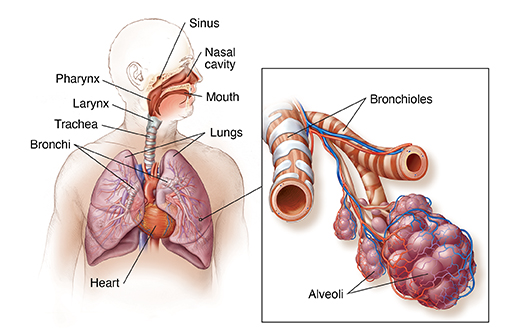Anatomy of the Respiratory System
Respiration
Respiration is the act of breathing:
Respiratory system
The respiratory system is made up of the organs included in the exchange of oxygen and carbon dioxide. The respiratory system is divided into two areas: the upper respiratory tract and the lower respiratory tract.
The upper respiratory tract is made up of the:
-
Nose
-
Nasal cavity
-
Mouth
-
Sinuses
-
Throat (pharynx)
-
Voice box (Larynx)
-
Windpipe (trachea)
The lower respiratory tract is made up of the:

Lungs
The lungs take in oxygen. Your body's cells need oxygen to live and carry out their normal functions. The lungs also get rid of carbon dioxide, a waste product of the cells.
The lungs are a pair of cone-shaped organs made up of spongy, pinkish-gray tissue. They take up most of the space in the chest (thorax).
The lungs are surrounded by a membrane (pleura).
The lungs are separated from each other by the mediastinum, an area that contains the:
The right lung has three sections, called lobes. The left lung has two lobes. When you breathe in:
-
Air enters your body through your nose or mouth.
-
Air then travels down the throat through the larynx and trachea.
-
Air goes into the lungs through tubes called main-stem bronchi.
One main-stem bronchus leads to the right lung and one to the left lung:
-
In the lungs, the main-stem bronchi divide into smaller bronchi.
-
The smaller bronchi divide into even smaller tubes (bronchioles).
-
Bronchioles end in tiny air sacs (alveoli) where the exchange of oxygen and carbon dioxide occurs.
You then breathe out carbon dioxide.
Online Medical Reviewer:
Deborah Pedersen MD
Online Medical Reviewer:
Jessica Gotwals RN BSN MPH
Online Medical Reviewer:
Tennille Dozier RN BSN RDMS
Date Last Reviewed:
8/1/2023
© 2000-2024 The StayWell Company, LLC. All rights reserved. This information is not intended as a substitute for professional medical care. Always follow your healthcare professional's instructions.